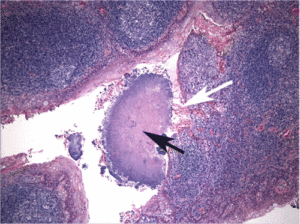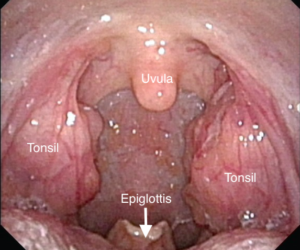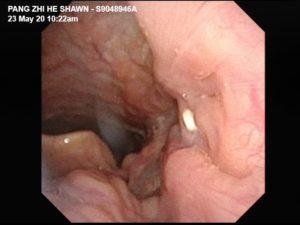Tonsil stones
Tonsil stones are small yellow particles that sit in small crypts or craters on the surface of your tonsils. The medical term for tonsil stones is tonsiloliths. Tonsils are small swellings that sit on the side walls of your throat. Tonsils have an irregular surface with little crypts. This gives them a pock-marked appearance. The picture below shows enlarged tonsils. In most people, tonsils are much smaller.
Tonsil stones cause bad breath (halitosis) and soreness. The picture below is of a tonsil stone sitting in the left tonsil. Often what you see is just the tip of the iceberg. The pocket in which a tonsil stone sits usually has a narrow neck. So as the stone enlarges, it is not possible to self extrude. Patients often resort to using toothpicks and cotton buds to try and dislodge these stones.
There are a variety of home remedies that are purported to help. These include gargling with apple cider vinegar and various over-the-counter antiseptics. Small tonsiloliths probably respond well to these simple measures but larger ones can be very stubborn.
Tonsil stones are in fact biofilms. Biofilms are a matrix of different bacteria. Imagine a corn cob made up of extracellular polymers where the kernels are various different bacteria. The bacteria deep within these corn cobs are starved of oxygen and nutrients and therefore grow very slowly. Antibiotics work on rapidly dividing bacteria, so biofilms help protect bacteria from antibiotics. Dental plaques are biofilms too and in many ways share similarities with tonsil stones. They both cause halitosis and can be very stubborn to eradicate.

Tonsil stone (black arrow) sitting within a crypt. There are inflammatory cells and fibrinous debris lining the crypt (white arrow). From Tonsillolith: Not Just a Stone but a Living Biofilm. Paul Stoodley et. al.
Inflammation of the tonsils is likely to cause tonsil stones. Persistent inflammation of the tonsils is also known as chronic tonsillitis. There are various factors that can predispose to chronic tonsillitis and therefore lead to tonsil stones. These include poor hydration, mouth breathing due to nasal blockage that causes dessication of the throat and tonsils, smoking, and acid reflux.
Managing tonsil stones
Patients with tonsil stones tend to feel very frustrated. The bad breath makes them self conscious. Soreness is often less troublesome. Most patients would have tried all sorts of remedies before presenting to a doctor.
Oral Hygiene
Good oral hygiene is important in managing tonsil stones. This includes good dental hygiene, flossing and brushing of the tongue surface. Gargling with an antiseptic (e.g. Listerine or Betadine) is helpful.
Managing contributing factors
Needless to say maintaining a healthy diet and stopping smoking are important. Most patients will have acid reflux – which can be silent – and they should be advised of lifestyle and dietary changes that reduce acid reflux. Selected patients may benefit from acid reflux medication with a proton pump inhibitor (e.g. omeprazole, rabeprazole).
Surgery
In cases where conservatives measures have failed, surgery may be necessary. Tonsillectomy is very effective. Once the tonsils are removed there is no place for tonsil stones to form. Some centres advocate ablation of the crypts that harbour tonsil stones. This procedure is called cryptolysis. It is less painful than tonsillectomy but runs the risk of stones recurring.
END
Share this blog via:









